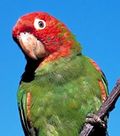 Imagine being lost deep in the woods, only to hear "Hello" or "What's Happening" come at you from afar. Hikers in Australia have increasingly been surprised to find no one there. Rather than hallucination, the calls have been coming from birds.
Imagine being lost deep in the woods, only to hear "Hello" or "What's Happening" come at you from afar. Hikers in Australia have increasingly been surprised to find no one there. Rather than hallucination, the calls have been coming from birds.
"Some chatty pet parrots that have escaped back into the wild have taught wild parrots to talk.
The learned behaviors could be integrated into the flock through generations. 'The evolution of language could well be passed on through the generations, says Ken. "If the parents are talkers and they produce chicks, their chicks are likely to pick up some of that," he says.
This phenomenon is not unique; some lyrebirds in southern Australia still reproduce the sounds of axes and old shutter-box cameras their ancestors once learnt.'"
The story of the 100th Monkey is similar, where island monkeys learned to wash sweet potatoes and supposedly began passing on the skill.
These phenomena remind me of how human Culture becomes codified and spreads. If a wild parrot can learn to talk in the wild, imagine what humans pick up from each other.
The point: maybe it's time to notice what your organization (or team) is learning in the wild and passing-on to each other?


Have you read “The Monkey in the Mirror”? What struck me is the theory that human self-awareness, particularly the ability to think symbolically could have stemmed from cro magnon children playing a game of naming things. The act of naming things wired their brains with the notion of self and other things. It’s been a while since I read the book, so I don’t recall details. But the notions in the book inspired my architectural choices while developing my SCL (Prolog-based language I developed) systems.